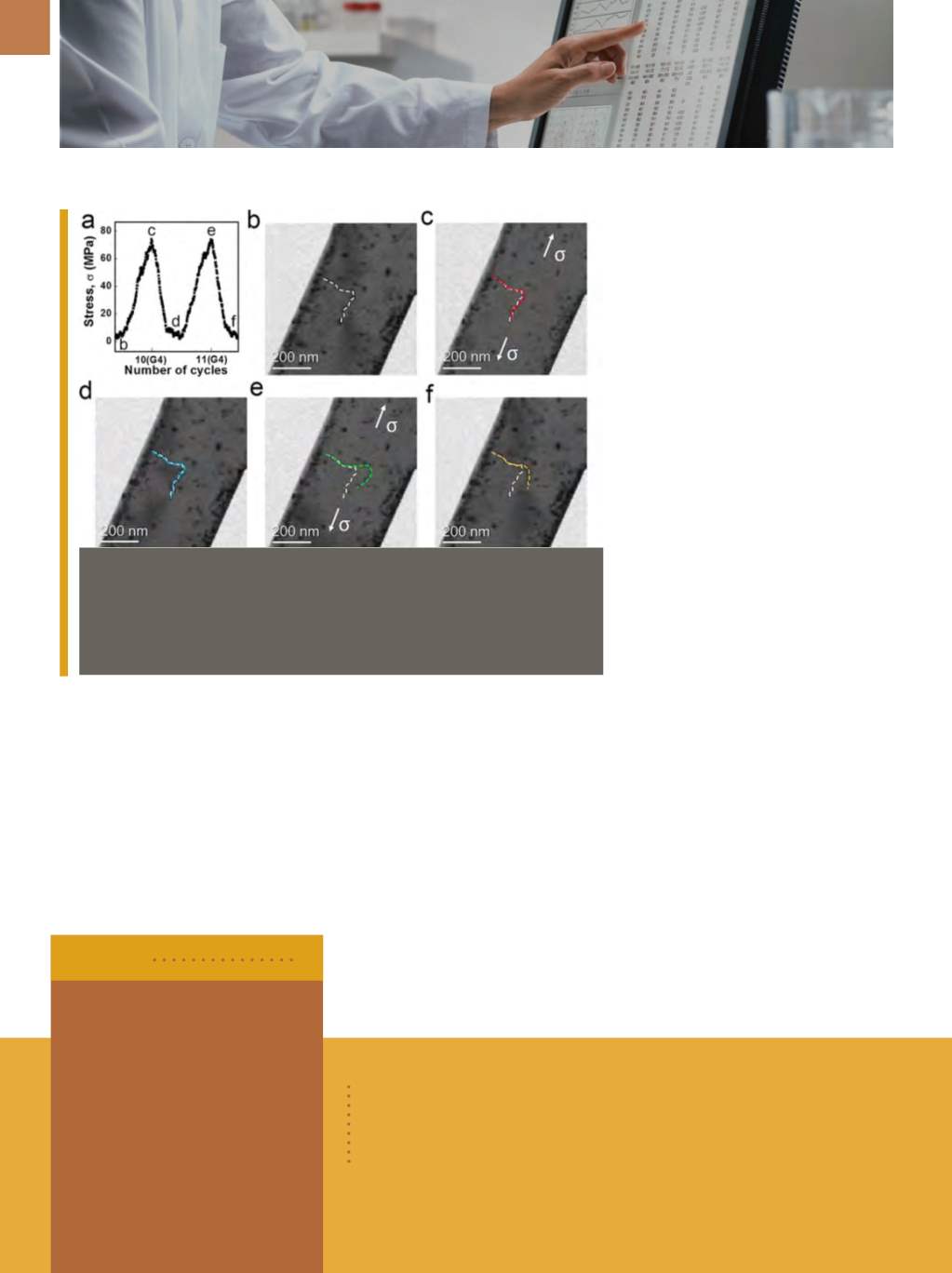

A D V A N C E D M A T E R I A L S & P R O C E S S E S | N O V E M B E R / D E C E M B E R 2 0 1 5
1 0
TESTING | CHARACTERIZATION
ELIMINATING METAL DEFECTS
WITH CYCLIC LOADING
Researchers from Massachusetts
Institute of Technology, Carnegie Mel-
lon University, Xi’an Jiaotong Univer-
sity, and elsewhere have found that
under certain conditions, repeated
stretching of nanoscale metal pieces
can actually strengthen a material by
eliminating defects in its crystalline
Abrupt depinning and destabilization of a line defect due to repeated cyclic loading;
(a) the evolution of nominal tensile stress during two loading and unloading cycles;
(b) to (f) are still frames from a video that correspond to the stress state marked
in (a), where white dashed lines indicate the original defect location, and colored
dashed lines represent the altered locations from cyclic loading. Direction of tensile
stretching is indicated by arrows in (c) and (e).
cyclic deformation, rather than heat-
based annealing.
Repeated small displacements
of metal tend to dislodge dislocations
from their pinned locations inside the
crystal. The small crystal has a high sur-
face-to-volume ratio, so dislocations are
attracted to the surface, and the energy
stored in the metal due to the presence
of the defects could be reduced.
By “shaking” the dislocations
gently and repeatedly, researchers
were able to get the material relatively
free of them, increasing the material’s
strength significantly. This phenom-
enon is counterintuitive, because it is
the opposite of what one sees in much
larger metal crystals, where repeated
stretching often increases defect
density and causes cracks to form.
Researchers believe the process could
help in the production of strong parts
for nanotechnology applications, such
as mechanical nanosensors, nanoelec-
tromechanical systems, and nanoro-
bots.
web.mit.edu,
cme.edu.
BROOKHAVEN HOSTS NEW
CENTER FOR COMPUTATIONAL
MATERIALS SCIENCES
The Department of Energy’s (DOE)
Brookhaven Lab, Upton, N.Y., will host
a new center devoted to developing
computational tools to advance mate-
rials science. With $12 million in fund-
ing from DOE’s Office of Basic Energy
Sciences over the next four years, this
center will be led by Gabriel Kotliar of
Rutgers University and Brookhaven,
structure. The new process is referred
to as
cyclic healing.
“Whilemetal fatigue has been stud-
ied at larger volumes of materials, there
has been little understanding of it at the
atomic scale,” says Ming Dao of MIT. To
remedy that, the team studied metal
fatigue using a transmission electron
microscope to observe atomic-scale
changes in defects. The primary subject
of the study was small, single-crystal
pieces of aluminum. Researchers aimed
to reduce or eliminate microstructural
imperfections—such as defects in the
crystal lattice known as dislocations—
through repeated, small-amplitude,
Bruker Corp.,
Billerica, Mass.,
will acquire
Jordan Valley Semi-
conductors Ltd.,
Israel, by the
end of 2015. Jordan Valley’s in-line
x-ray metrology products comple-
ment Bruker’s portfolio of analyti-
cal x-ray technologies, say compa-
ny sources.
bruker.com.
BRIEFS
Boise State University,
Idaho, will receive a $25 million gift from the
Micron Foundation.
It is the largest gift in the university’s history, and
will fund the establishment of the new Micron Center for Materials
Research, operated by the College of Engineering.
go.boisestate.edu.


















